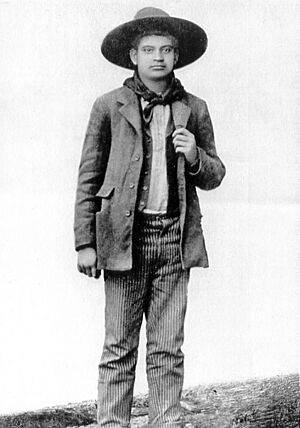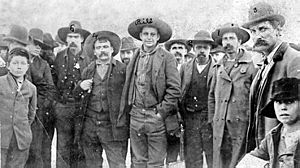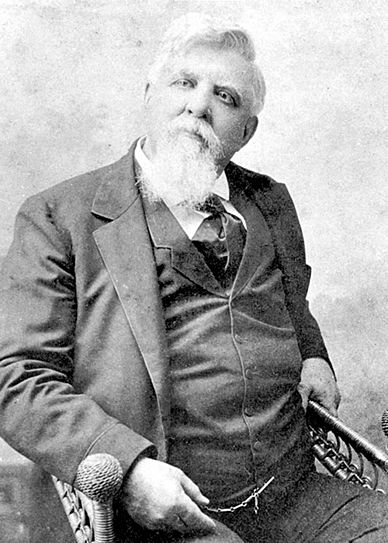Crawford Goldsby facts for kids
Quick facts for kids
Crawford Goldsby
|
|
|---|---|
| Born | February 8, 1876 San Angelo, Texas, United States
|
| Died | March 17, 1896 (aged 20) |
| Other names | Cherokee Bill |
| Occupation | old west outlaw/robber |
| Parent(s) | George and Ellen (Beck) Goldsby |
Crawford Goldsby (born February 8, 1876 – died March 17, 1896) was a famous outlaw from the 1800s in America. He was better known by his nickname, Cherokee Bill. He was involved in many dangerous actions and crimes. He and his group caused a lot of trouble in the Indian Territory for more than two years.
Contents
Who Was Cherokee Bill's Family?
Crawford's father, George Goldsby, was from Perry County, Alabama. He was a sergeant in the Tenth United States Cavalry. This group was known as the Buffalo Soldiers. His mother, Ellen Beck, was a Cherokee freedman. She had a mix of African, Native, and white family history.
Crawford had one sister named Georgia, and two brothers named Luther and Clarence. His father, George Goldsby, was born in Alabama in 1843. He had several brothers and sisters too.
George Goldsby worked as a helper for a Confederate army group during the American Civil War. He later left and joined the Union Army under a different name. After the war, he returned to Alabama. But because he had fought with the Union Army, he left for the Indian Territory to avoid trouble. In 1867, he joined the 10th Cavalry Regiment as a Buffalo Soldier. He became a sergeant major and later a first sergeant.
Cherokee Bill's Early Life
Crawford Goldsby was born on February 8, 1876, in San Angelo, Texas. When Crawford was two years old, some serious problems started in San Angelo. There were fights between the black soldiers and local cowboys and hunters. One big fight happened in a saloon. Some cowboys attacked a soldier, and the soldier brought back friends. A gunfight started, and some people were hurt or killed.
Texas Rangers tried to arrest Crawford's father, George Goldsby. They said he was responsible for the soldiers having weapons. Colonel Benjamin Grierson, the fort commander, said the Rangers had no right to arrest someone on a federal fort. George Goldsby knew the army might not protect him outside the fort. So, he left without permission.
After his father left, Crawford's mother, Ellen Beck Goldsby, moved to Fort Gibson, Indian Territory. She left young Crawford with an older woman named "Aunty" Amanda Foster. He stayed with her until he was seven. Then, Crawford went to an Indian school in Cherokee, Kansas. When he was 12, he came back home to Fort Gibson.
When Crawford returned, he found out his mother had remarried. Her new husband was William Lynch, a soldier in the 9th Cavalry. Crawford and his stepfather did not get along well. Crawford started spending time with people who caused trouble. He also began to rebel against rules. By age 15, he moved in with his sister and her husband, Mose Brown. But he didn't stay long because he and Mose didn't get along either. He went back to Fort Gibson and worked odd jobs.
Becoming an Outlaw
Crawford Goldsby started his life as an outlaw when he was 18. At a dance in Fort Gibson, he had an argument with a man named Jake Lewis. A few days later, Goldsby shot Lewis. Thinking Lewis was dead, Goldsby ran away from Fort Gibson. He went to the Creek and Seminole Nations. There, he met two outlaw brothers, Jim and Bill Cook, who were part Cherokee.
In the summer of 1894, the U.S. government bought land from the Cherokee people. They agreed to pay money to everyone who had a legal claim. Since Goldsby and the Cook brothers were part Cherokee, they went to Tahlequah, Oklahoma. This was the capital of the Cherokee Nation. They wanted to get their money.
Goldsby was wanted for shooting Lewis, and Jim Cook was wanted for stealing. They didn't want the police to see them. So, they stopped at a hotel run by a friend, Effie Crittenden. They asked her to go to Tahlequah to get their money. On her way back, Sheriff Ellis Rattling Gourd followed her. He hoped to catch Goldsby and the Cooks.
On June 17, 1894, Sheriff Rattling Gourd and his group had a gunfight with Goldsby and the Cook brothers. One of the sheriff's men, Deputy Sequoyah Houston, was killed. Jim Cook was also hurt. The police left. Later, when Effie Crittenden was asked about the fight, she said it wasn't Goldsby, but "Cherokee Bill." After this, Crawford Goldsby got his famous nickname. He became known as one of the most dangerous men in the Indian Territory.
After this event, the Cooks and Goldsby formed a group called the Cook Gang. They started causing trouble in Oklahoma. Between August and October, Goldsby and the Cooks committed many crimes. They robbed banks, stagecoaches, and stores. They also hurt people who tried to stop them. Around this time, Goldsby started losing his hair due to a family condition. He decided to shave the rest of it off.
Jail Break Attempt
Because of a serious incident, the police worked harder to catch Goldsby and the Cook Gang. The gang split up due to the pressure. Most of the men were caught or killed, but Goldsby managed to escape. The police offered a $1300 reward for Goldsby's capture. Some people who knew him came forward to help.
On January 31, 1895, Ike Rogers and Clint Scales captured Goldsby in Nowata, Oklahoma. He was taken to Fort Smith, Arkansas, to await his trial.
On April 13, 1895, he was found guilty of a crime and sentenced to death. However, his lawyer was able to delay the execution date.
In June 1895, a pistol was found in the Fort Smith jail. Goldsby said that a prisoner who helped around the jail, named Ben Howell, had brought the gun in and then ran away.
Meanwhile, Goldsby had made friends with Sherman Vann, another prisoner who helped around the jail. Sherman managed to sneak a revolver into Goldsby's cell.
On July 26, 1895, Goldsby tried to escape from jail using the gun. He surprised the night guards as they came to lock him in his cell. A guard, Lawrence Keating, was shot. Other guards arrived and stopped Goldsby from escaping. They couldn't get into the jail either. Then, another prisoner named Henry Starr convinced the guards to let him go in and get Goldsby. Moments later, he came back with Goldsby, who no longer had the weapon.
Execution
Goldsby's second trial lasted three days. He was found guilty again. Judge Isaac Parker sentenced Goldsby to be executed on September 10, 1895. But his lawyers appealed to the Supreme Court, which delayed the execution. On December 2, the Supreme Court agreed with the Fort Smith court's decision. Judge Parker then set the new execution date for March 17, 1896.
After his death, Crawford's mother, Ellen, and sister, Georgia, took his body to Fort Gibson, Oklahoma. He was buried in the Cherokee National Cemetery.
On April 20, 1897, Ike Rogers, one of the men who helped capture Cherokee Bill, was shot and killed by Clarence Goldsby, Crawford's brother, in Fort Gibson, Oklahoma.
Cherokee Bill in Pop Culture
In the 2021 movie The Harder They Fall, the character of Cherokee Bill is played by actor Lakeith Stanfield.
Actor Pat Hogan played Cherokee Bill in a 1955 episode of the TV show Stories of the Century.
See also
 In Spanish: Crawford Goldsby para niños
In Spanish: Crawford Goldsby para niños





